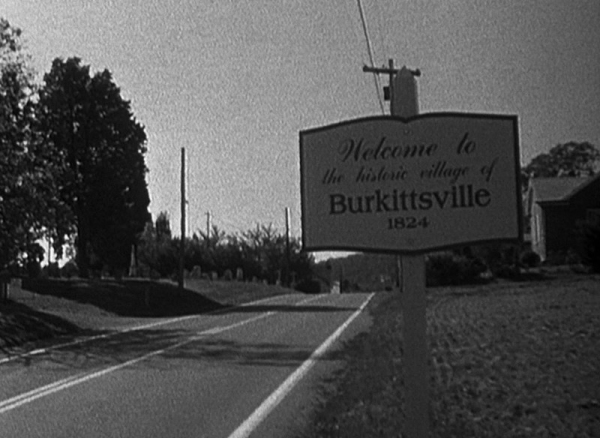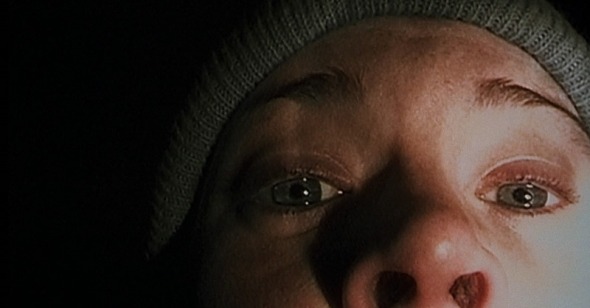Unearthed: The Blair Witch Project
By Nicholas Russell
In late September 2023, New York was hit by a severe rainstorm that flooded many parts of the city. Basement-level apartments overflowed, brackish standing water rising taller than some bookshelves, raw sewage dribbling from toilets. Pedestrians crossed streets that quickly turned to rivers, ankle-high, then knee-high. The subways closed. Intrepid, or maybe just foolish, drivers, steering against strong currents, tried to push past a downpour that, in the most extreme cases, lifted and washed away their vehicles. Though the final Friday in September witnessed dramatic, often dire instances of crumbling infrastructure and desperation, more than 14 inches of rain fell throughout the entire month, the most since September of 1882, 140 years ago. Earlier that same month, flash-flooding hit Las Vegas, with many of the same types of scenes repeated. Stranded cars, roads filled with rushing water, backyards and ground-level dwellings puddled with rain like sweat bubbling up from the ground.
Social media was inundated with the most outrageous moments from both events, portrait-oriented phone cameras pushing in on jets of water streaming from between cracks in subway walls, slow pans following white water down highways with desert mountains in the background. Traditional news has had a difficult time competing with the amateur on-the-scene journalism of normal people documenting their lives falling apart in real time. What can seem frightening yet distant when seen through a screen can instantly turn into true terror when one checks the location and timestamp of footage taken minutes ago not five blocks from your own house. One person’s subjectivity affects and infects your own.
And then, one hour, one day, one week later, that footage transforms again, from a broadcast into a record. Looking back, that which unfolded live now unfolds in a never-ending loop, and what becomes more apparent is the limited scope of the person filming, the details that are most salient and urgent to them. This is the purview of the found-footage movie genre, the blinkered and utterly biased perspectives of those whose lives shift from the present tense to the past.
As a cinematic form, found footage is lashed more tightly to the parameters of time and place than most others. Its most effective practitioners utilize the supposition of a real-life recording and bend the world of the film to a shape recognizable but also indelibly skewed. The stagehands rushing to change the set in the background are never seen because the audience is led to believe that there is no one else behind the camera. What we see must maintain its aesthetic, emotional, and/or dramatic veracity, even in moments of utter absurdity. The rug pull happens moment by moment, inch by inch, this unstable evidence breaking, dragging you down with it, the point of “real” or not losing importance. This column may err on the side of found footage’s implications and innovations in the realm of horror, but it also aims to interrogate the notion of personal authorship; the ubiquity of recorded existence, fictional and non, that proliferates our increasingly digital world; and the manner in which, much like a film being finished after it’s seen by an audience, a person’s life may be granted legitimacy once documented and shared.

The directors of The Blair Witch Project say they weren’t really trying to fool anyone. Or rather, they didn’t intend to pass off their “completely improvised feature film” as a snuff picture, as “real” evidence of a trio of young filmmakers—Heather, Mike, and Josh—lost and then tragically disappeared in the Maryland woods. It didn’t hurt for viewers to think otherwise. In a 1999 interview with The Onion, several months after The Blair Witch Project’s high-profile premiere and subsequent acquisition at Sundance, and a day before its summer wide release, co-director Eduardo Sanchez said, “We didn't want to tell people that it was real, but we didn’t want to tell people it was fake, either. We wanted to walk that line, you know?”
It’s unfortunate, though perhaps inevitable, that at the time and on the precipice of such explosive success, Sanchez and Daniel Myrick couldn’t help but outline the contours of their experiment in terms plain, simple, and cautionary, doing due diligence to the supposed authenticity of their film while also stepping back from a statement of audacious, outright falsity. By then, the website for The Blair Witch Project, littered with additional materials (interviews, missing person posters, photos), had served to burnish, or maybe just obfuscate, what few truths were available to the public. The supposed artifacts, convincingly and understatedly rendered, spoke for themselves. How much more (or less) integral to the history of the genre would the film have been if the directors had said nothing?
Of course, that supposition rests on the idea that found-footage horror is only about evidence as a source of suspended disbelief, only about the plausible reproduction of material reality. The Blair Witch Project was not the first film of its kind, nor was it necessarily the most technically accomplished. That it forever altered the cinematic language of found footage by tying a genre that had been largely connected to cinema vérité and psychological explorations—such as Shirley Clarke’s The Connection (1961) and Robert Jan Westdjik’s Little Sister (1995)— to horror, is a shift its filmmakers couldn’t have anticipated. And yet it makes sense that found footage became one of horror’s best-realized materials, rendering the otherworldly and terrible as believable, plausible, real.
There’s always been a Dateline-esque quality to most found-footage films, this prurient, gonzo immediacy that’s also known to be doctored. Think of the famous “Patterson-Gimlin” film from 1967, the most iconic instance of so-called Bigfoot footage and the most absurd: a bipedal, furred figure walking through the woods and turning toward the camera. How something so clearly a hoax could be reclaimed as truth emphasizes the importance of how a piece of film is framed, how it’s gussied up and paraded around as evidence.
Any reduction of The Blair Witch Project’s success as only due to its viral marketing campaign supposes that the film’s aesthetic presentation—as a reel of actual footage shot by actual missing people—was the most important factor in suspending the audience’s disbelief, rather than the strength of the film’s structure, its actors, and the natural limitation of the genre. At the very least, it seems a mistake to retroactively graft the now-vaunted legacy of The Blair Witch Project onto the final product of an experiment that directors Sanchez and Myrick had no idea would be so successful. The believability of fictionalized found footage has never only had to do with the question of what an audience knows going in. The Blair Witch Project stands the test of time in part by virtue of its most famous moments—those hand-made wooden totems, Heather’s on-camera breakdown, Mike standing in the corner—passing into the cultural lexicon and still holding a collective experience far more terrifying and emotionally unsettling than the sum of its parts.
By the late ’90s, the role of the documentarian was becoming increasingly democratized, cameras getting smaller and cheaper, the medium for capturing both professional and amateur footage swiftly shifting from tape to digital files. The increased portability of the camera brought about even more spectacularly intimate modes of filming, some of them conventional but heightened, others truly novel. In the rare case of an iconic scene expressing so much more than its memeified history would indicate, the prolonged forward-facing confessional of Heather crying and apologizing in the dark stands out for what it doesn’t show. The photographer as subject carries with it a sense of playfulness, a private amusement at being scrutinized by oneself. Vivian Maier’s wondrous candid self-portraits—taken via shop windows, mirrors, and her own shadow—draw the spectator in, at least partially, for what isn’t shown: Maier setting her aperture, considering her appearance, waiting for a passerby to move, looking at the light, gauging the moment, pressing the shutter. Similarly, Heather’s desperate plea for help—for forgiveness, for certainty—comes after the suspicion of any deliberate misdirection or staging has long since passed. Considering how much she, Mike, and Josh have fussed over the framing of their film thus far, the scene is all the more shocking for how dashed-off and raw it appears, Heather’s face cut in half by the frame, her skin periodically washed out by the flashlight, the knowledge that Mike is nearby but unaware of what she’s doing. The moment casts aside any doubt of what we’re seeing. Heather’s sheer proximity to the camera, that prolonged, filmed vulnerability, becomes the visual stand-in for the mythology of the Blair Witch, whom, after all, we never see.
It’s a testament to The Blair Witch Project’s faithful adherence to the unadorned format of the found-footage genre—no nondiegetic music, no obvious or intrusive sound design—and the fear it inspires that I am repeatedly surprised that the film’s final moments in the dilapidated house take place with few words and even fewer sounds. No matter how many times I’ve watched these closing scenes, my recollection inserts some generic bit of enhanced Foley, some atonal piece of tense emphatic music that renders the sequence rote, conventional, safe. Perhaps it’s because the found-footage format reaches the zenith of its chill-inducing potential here at the climax, in a film where everything goes wrong, when the inevitable tragic end rushes in so suddenly.
When the audience finally watches Heather and Mike arrive at the abandoned house of Rustin Parr, the murderous hermit who is said to have abducted and killed seven children in the 1940s, The Blair Witch Project’s stitched-together storytelling has almost entirely come apart. Instead, the film unfolds as one long and terrible moment that neither the person behind the camera nor the audience wants to continue. We don’t notice, or maybe no longer care, who has edited this footage together, who has made the choice, within the fiction of the film, to toggle back and forth between Heather’s black-and-white 16mm film and Mike’s Hi8 camcorder. What might be Josh’s distant voice howls through the rotted foundations of the house, both Heather and Mike swinging their lights around every corner, sometimes too frightened to fully bring their hands up to record what they see.
A lingering influence of The Blair Witch Project on subsequent found-footage horror films is the blurred, harried images of a camera pointed at the moving ground. The person filming is running away, struck by an unseen force which sends the camera flying, and for once, becomes uninterested in documenting anything. These can often be the most frustrating scenes to watch when marshaled as filler, as a transition from one setup to the next. Also there is the overwhelming and distracting sound of the rattling, jostled camera itself. It makes The Blair Witch Project’s conclusion all the more unsettling by comparison: the footsteps of Heather and Mike, their labored breathing, and far-off yet claustrophobically close screams. Cleverly, Sanchez and Myrick utilize the very footage itself as an extension of character. By the end, there is simply too much to deal with for either Heather or Mike to properly film. Mike is attacked quickly, his camera falling to the floor before we’ve fully registered what’s happened. Heather screams as she carries the 16mm camera and searches for Mike. Indeed, captured by Mike’s DAT recorder, which is already somewhere in the darkness of the cellar, her screams seem—and in a sense are—disembodied, a consciousness ripped from its foundations, utterly consumed by fear. Mike stands in the corner, facing the wall, Heather screams, then the image falls to the ground, film stuttering as the lens points to the wall. The audience can imagine exactly how the camera will be found.
